
Canada Topflight Academy’s Partnership Proving to be a Win-Win
The Canada Topflight Academy’s (CTA) dominance extends far beyond the basketball court. Since its inception in 2016, the program has pioneered and established a new framework of success for preparatory programs across the nation.
Earlier this year, the Ottawa based program won its second consecutive National Championship; an unprecedented feat for a program that was founded just two years ago. On the court, CTA has adopted a true team first style of play, with each player being well-rounded and consistent – a playing style that is appropriately reflective of the program itself. CTA prides itself on working hard, acting with integrity and character, and being appreciative of not just the game but also its community.
The National Capital Region, like many regions across Canada, always had its fair share of talent but initially lacked the infrastructure to support high-level player development. As a result, Ottawa’s elite basketball players had two primary options to gain exposure: move to Toronto or the United States. This did not mesh well with CTA founder Tony House, who had a vision to not only retain Ottawa’s best players and keep them in the city, but provide them with a platform to optimize their exposure, player development, and education.
“I was frustrated five years ago when prep schools started to rise in Canada,” says House. “Kids just couldn’t stay in Ottawa. I felt that if we could start something locally, the players would be happy to stay in town. They could sleep in their own beds, eat at their own homes, and not have to be away from family.”
House realized that the most impactful way to establish long-term, sustainable program success would be to establish a partnership between the CTA and the Ottawa Catholic School Board (OCSB), an organization that he had over five years of work experience with. By leveraging the relationships he had established during his tenure with the school board, House was able to connect and meet with several principals in the Board to effectively portray the value of his proposed model.

His vision was simple – CTA students would be the embodiment of true student-athletes. Players would seamlessly integrate with the students in their home-school, attending each class and maintain excellent academic performance. Once class was finished for the day, the athletes would practice with their CTA team.
“From what we know, this is the first official prep school partnership with a school board,” says House. “And it really is a full on partnership. The Board has been incredible; opening their boundaries to allow for the best players to attend their schools, giving our students access to all the facilities and resources that other students would have access to, providing us with dedicated guidance counsellors and classrooms that we can use for study hall and film sessions, among other things. This truly is a partnership and alliance.”
CTA currently offers three distinct programs, all being held at different schools across Ottawa. The Senior Boys team attends school and practices at Notre Dame High School while the Senior Girls and Junior Boys teams attend Immaculata High School and St. Pius X High School, respectively. The primary benefit of having the programs at different locations is based on gym time and gym availability. CTA programs have found a way to seamlessly fit in with their host school’s academic and extra-curricular programs, something that would be far more difficult with multiple programs taking place at the same school.
Tom D’amico, the Associate Director of Education for the OCSB feels that the guidelines established between the Academy and the OCSB prior to the partnership have enabled the endeavour to be successful. The first guideline was to ensure that academic integrity was adhered to at all times. The second was that the CTA athletes would not participate on other regular sports teams for that school.
“One of our reasons for being involved was to ensure academic integrity, with the second goal to promote player well-being,” says D’amico. “We do not believe that an athlete who is identified as a high performance athlete should be training for the elite team, and then also the school team. Students would burn out if they tried to maintain both. To make sure this doesn’t happen, our high performance athlete programs are ensured modified schedules and academic support, along with support in other areas including nutrition and time management.”
The number of existing scandals amongst academic institutions and how they’ve treated their high level athletes, specifically with respect to the education that they’ve received are endless. Given this, CTA and the OCSB placed a high degree of emphasis on maintaining a high level of education for all athletes.
“We witnessed other models where the reputation of the program was that they were “giving away credits” and from the start this was not going to be our model,” states D’amico. “ We focused on personalized learning for each student-athlete while being flexible with delivery and assessment but not lowering our academic standards.”
In just two short years, CTA has made a profound impact on the players that have gone through its system. If the academy didn’t exist, the select few who could afford it or received a scholarship would be able to relocate and attend prep school elsewhere. It would be nearly impossible for the remaining players to receive the training and exposure that they’re receiving at CTA, elsewhere in Ottawa.
“I used to coach local high school basketball and unfortunately, the reality is all the best players are going prep. Even a really good high school program can’t simulate what CTA does when it’s essentially an all-star, prep team. All the best players come to one gym, work out five times a week, and play against the best programs in Canada and the USA.”
Despite the program’s success, Tony House acknowledges that its legacy is greater than basketball.
“We had seven athletes graduate this year and they all went to post-secondary. The main impact CTA has had lies in ability to propel students to the next stage. I know it’s working because we’re seeing the fruits of our labour first hand, and we’ll just continue to grow it.”
According to D’amico, CTA’s impact extends far beyond the athletes themselves.
“The students model discipline, positive behaviour, and dedication to their sport. Since academic integrity is a key component of the program, other students see and respect their focus on both academics and basketball.”
Notre Dame High School Principal, Michael Curry, is a strong advocate of the partnership.
“The students are polite and good additions to our school,” says Curry. “In fact, one graduating student from the CTA has been our top student during his time here – so that certainly helps demonstrate the academic commitment of the athletes.”
Curry acknowledges the challenges that the prep school students may face and believes that the best way to mitigate the challenges is by accommodating wherever possible.
“There were concerns initially about the students being treated differently and to a certain extent, you have to support their different travelling schedules, practices, etc. But our staff have been supportive since they’ve seen the program in action. They’ve been accommodating to the athletes and this has been done in support of all players.”
The success of CTA’s athletes, both on and off the court, begs the question of why other school boards and programs haven’t adopted a similar model of partnership. All stakeholders in the partnership are thriving. It is becoming apparent that with the influx of preparatory programs across Canada, school boards will have to become more forward-thinking and partner with the programs, rather than oppose them.
And if CTA is any indication, there is little reason not to embrace the new wave.

